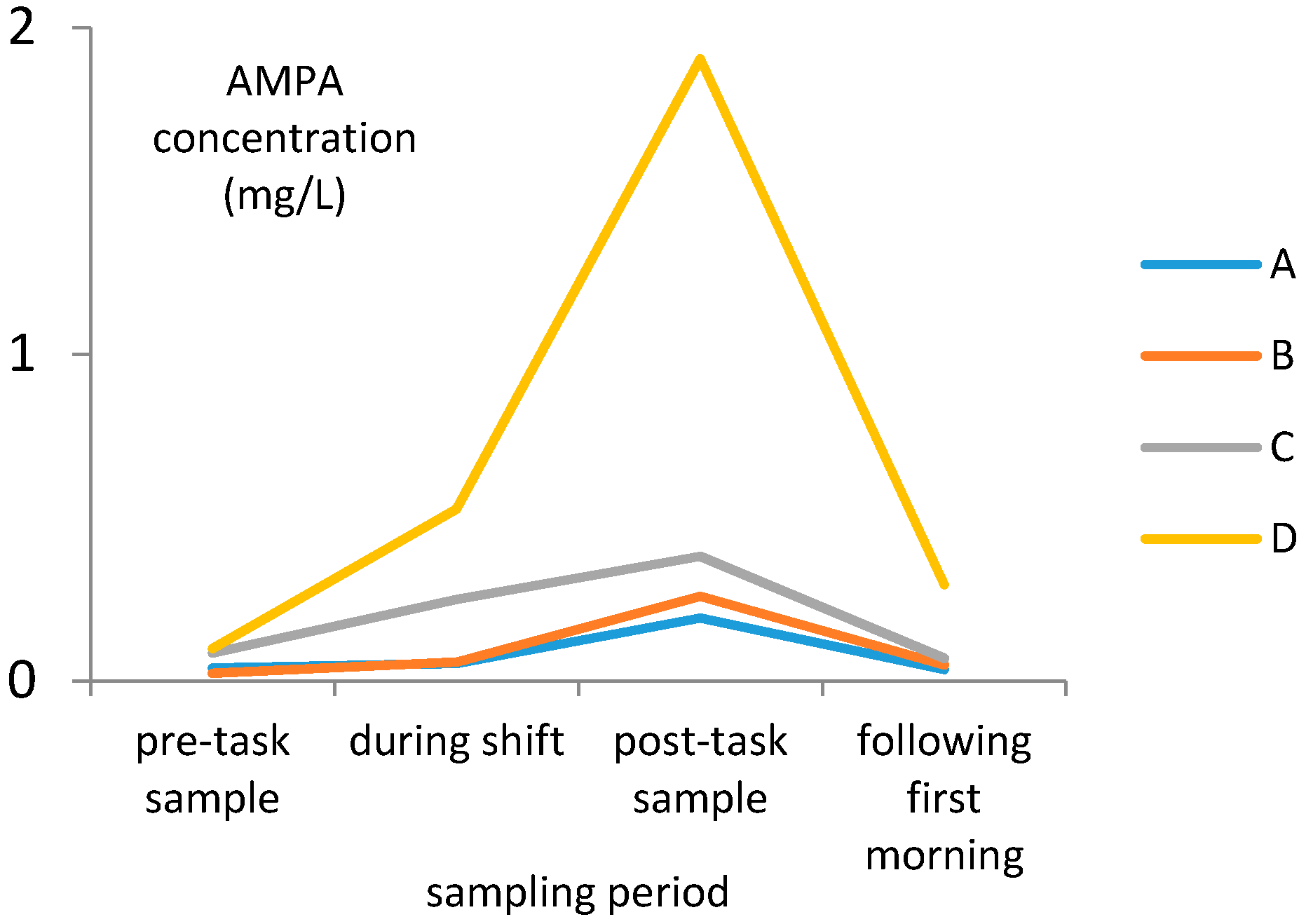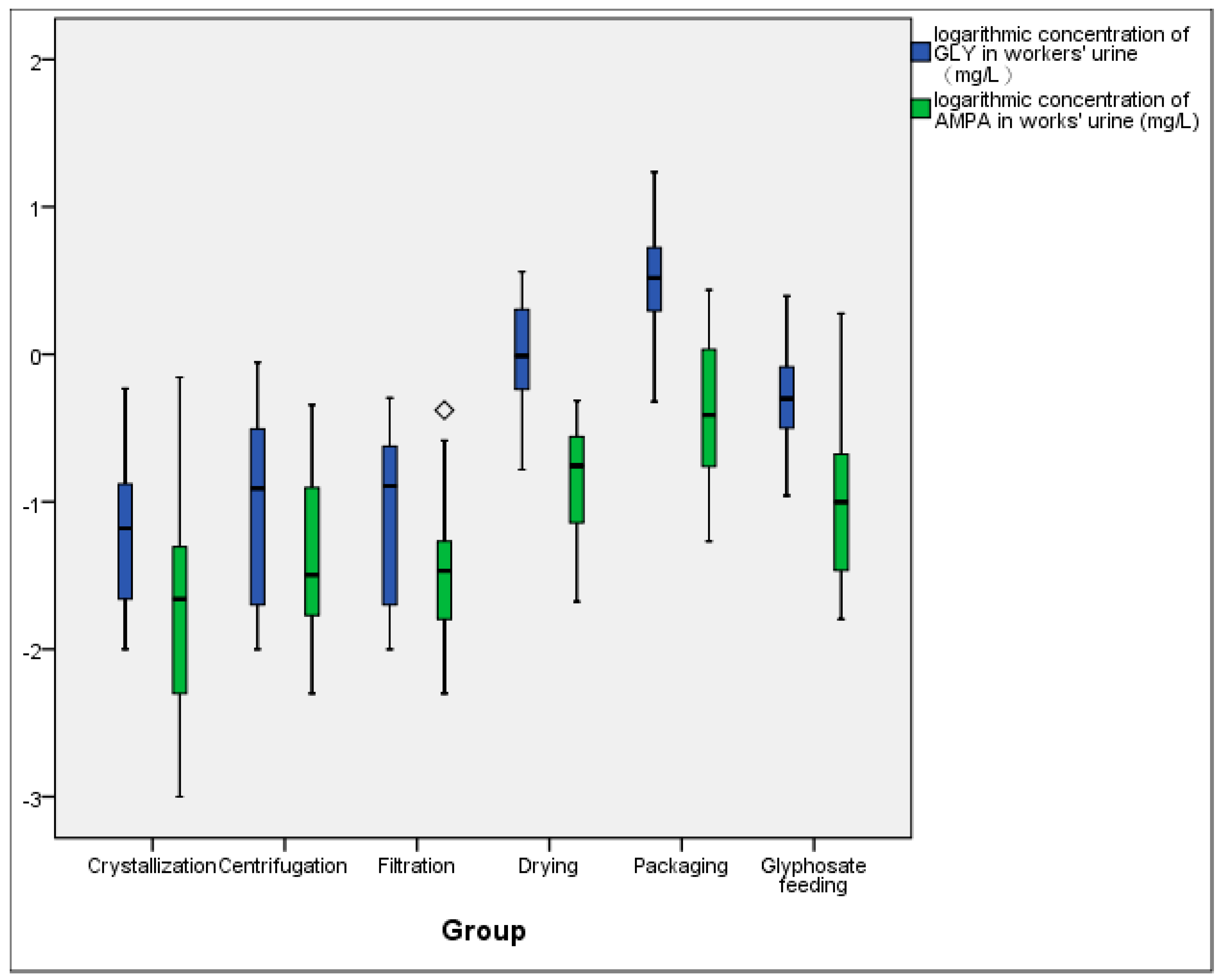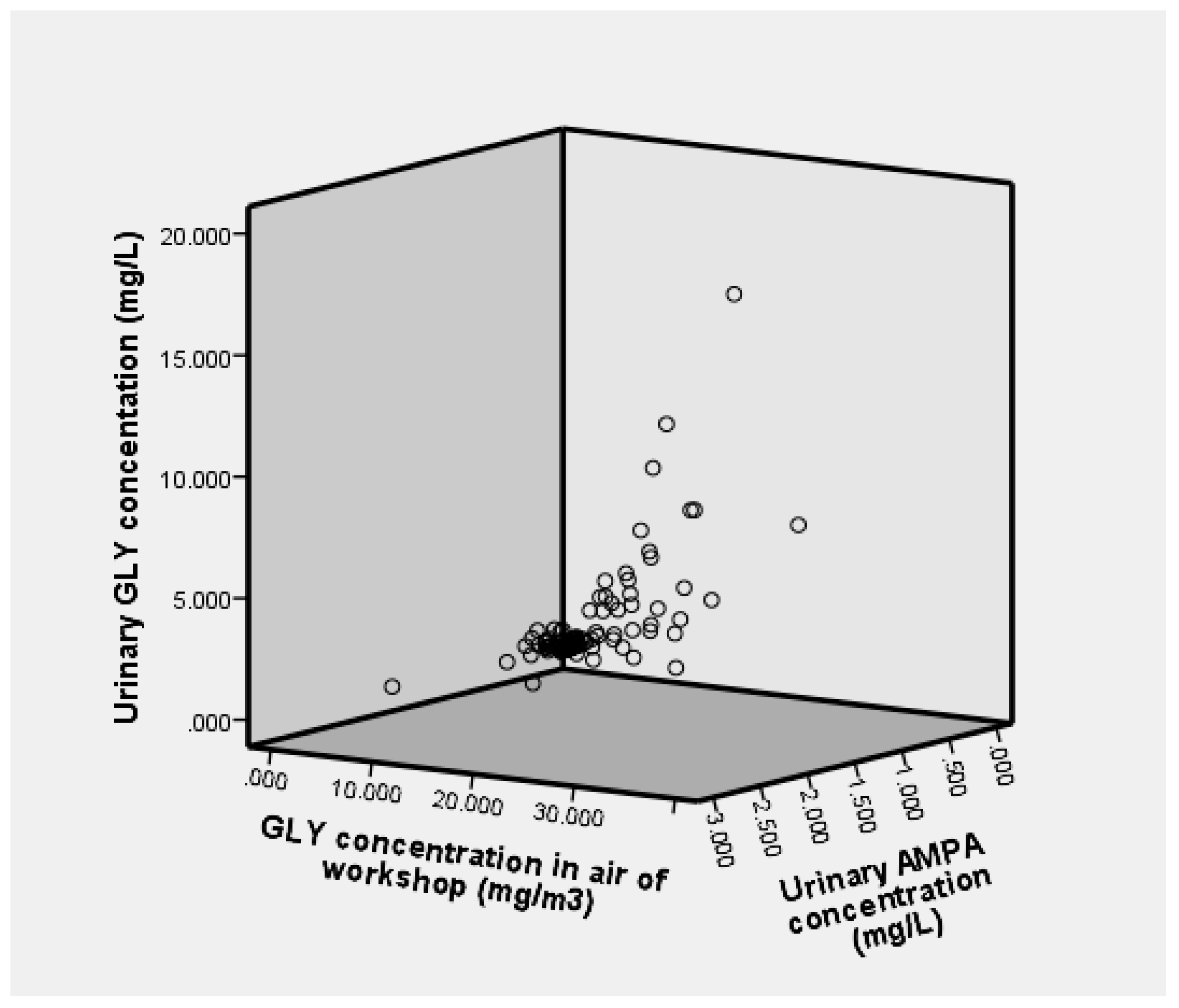Concentration Distribution and Analysis of Urinary Glyphosate and Its Metabolites in Occupationally Exposed Workers in Eastern China
Abstract
:1. Background
2. Materials and Methods
2.1. Study Design
Selection of GLY Production Facilities
2.2. Subject Selection
2.3. Method
2.3.1. Workshop Investigation
2.3.2. Determination and Calculation of External Dose
2.3.3. Urine Sample Collection and Concentration Determination
2.3.4. Questionnaire Completion
2.4. Statistical Analysis
3. Results
4. Discussion
5. Conclusions
Author Contributions
Funding
Conflicts of Interest
Declarations
Availability of Data and Materials
Abbreviations
References
- Duke, S.O.; Powles, S.B. Glyphosate: A once-in-a-century herbicide. Pest Manag. Sci. 2008, 64, 319–325. [Google Scholar] [CrossRef]
- Steinmann, H.H.; Dickeduisberg, M.; Theisen, L. Uses and benefits of glyphosate in German arable farming. Crop Prot. 2012, 42, 164–169. [Google Scholar] [CrossRef]
- Gianessi, L.; Williams, A. Overlooking the obvious: The opportunity for herbicides in Africa. Outlooks Pest Manag. 2011, 22, 211–215. [Google Scholar] [CrossRef]
- De Roos, A.J.; Blair, A.; Rusiecki, J.A.; Hoppin, A.J.; Svec, M.; Dosemeci, M.; Sandler, D.P.; Alavanja, M.C. Cancer incidence among glyphosate-exposed pesticide applicators in the agricultural health study. Environ. Health Perspect. 2005, 113, 49–54. [Google Scholar] [CrossRef] [PubMed]
- Williams, A.L.; Watson, R.E.; DeSesso, J.M. Developmental and reproductive outcomes in humans and animals after glyphosate exposure: A critical analysis. J. Toxicol. Environ. Health Part B Crit. Rev. 2012, 15, 39–96. [Google Scholar] [CrossRef] [PubMed]
- Wang, G.; Fan, X.N.; Tan, Y.Y.; Cheng, Q.; Chen, S.D. Parkinsonism after chronic occupational exposure to glyphosate. Parkinsonism Relat. Disorders 2011, 17, 486–487. [Google Scholar] [CrossRef]
- Jayasumana, C.; Paranagama, P.; Agampodi, S.; Wijewardane, C.; Gunatilake, S.; Siribaddana, S. Drinking well water and occupational exposure to Herbicides is associated with chronic kidney disease, in Padavi-Sripura, Sri Lanka. Environ. Health 2015, 14, 1–10. [Google Scholar] [CrossRef] [Green Version]
- Mesnage, R.; Defarge, N.; Spironx, J. Potential toxic effects of glyphosate and its commercial formulations below regulatory limits. Food Chem. Toxicol. 2015, 84, 133–153. [Google Scholar] [CrossRef] [Green Version]
- Trasande, L.; Aldana, S.I.; Trachtman, H.; Kannan, K.; Morrison, D.; Christakis, D.A.; Whitlock, K.; Messito, M.J.; Gross, R.S.; Karthikraj, R.; et al. Glyphosate exposures and kidney injury biomarkers in infants and young children. Environ. Pollut. 2020, 256, 113334. [Google Scholar] [CrossRef]
- Eriguchi, M.; Iida, K.; Ikeda, S.; Osoegawa, M.; Nishioka, K.; Hattori, N.; Nagayama, H.; Hara, H. Parkinsonism relating to intoxication with glyphosate: A case report. Intern. Med. 2019, 58, 1935–1938. [Google Scholar] [CrossRef] [Green Version]
- Wang, D.; Zhang, G.; Zhang, W.; Luo, J.; Zhu, L.; Hu, J. Successful extracorporeal membrane oxygenation support for severe acute diquat and glyphosate poisoning: A case report. Medicine (Baltimore) 2019, 98, e14414. [Google Scholar] [CrossRef] [PubMed]
- Mink, P.J.; Mandel, J.S.; Lundin, J.I.; Sceurman, B.K. Epidemiologic studies of glyphosate and non-cancer health outcomes: A review. Regul. Toxicol. Pharmacol. 2011, 61, 172–184. [Google Scholar] [CrossRef] [PubMed]
- Dedeke, G.A.; Owagboriaye, F.O.; Ademolu, K.O.; Olujimi, O.O.; Aladesida, A.A. Comparative assessment on mechanism underlying renal toxicity of commercial formulation of roundup herbicide and glyphosate alone in male albino rat. Int. J. Toxicol. 2018, 37, 285–295. [Google Scholar] [CrossRef] [PubMed]
- Zhou, C.F.; Li, Y.; Zhang, X.Y.; Yu, Y.C. Research progress on toxicity of glyphosate. Ecol. Environ. Sci. 2013, 22, 1737–1743. [Google Scholar]
- Gunarathna, S.; Gunawardana, B.; Jayaweera, M.; Manatunge, J.; Zoysa, K. Glyphosate and AMPA of agricultural soil, surface water, groundwater and sediments in areas prevalent with chronic kidney disease of unknown etiology, Sri Lanka. J. Environ. Sci. Health B 2018, 53, 729–737. [Google Scholar] [CrossRef]
- Tarone, R.E. On the International Agency for Research on Cancer classification of glyphosate as a probable human carcinogen. Eur. J. Cancer Prev. 2018, 27, 82–87. [Google Scholar] [CrossRef] [Green Version]
- Andreotti, G.; Koutros, S.; Hofmann, J.N.; Sandler, D.P.; Lubin, J.H.; Lynch, C.F.; Lerro, C.C.; De Roos, A.J.; Parks, C.G.; Alavanja, M.C.; et al. Glyphosate use and cancer incidence in the Agricultural Health Study. J. Natl. Cancer Inst. 2018, 110, 509–516. [Google Scholar] [CrossRef] [Green Version]
- Mink, P.J.; Mandel, J.S.; Sceurman, B.K.; Lundin, J.I. Epidemiologic studies of glyphosate and cancer: A review. Regul. Toxicol. Pharmacol. 2012, 63, 440–452. [Google Scholar] [CrossRef]
- Williams, G.M.; Kroes, R.; Munro, I.C. Safety evaluation and risk assessment of the herbicide roundup and its active ingredient, glyphosate, for humans. Regul. Toxicol. Pharmacol. 2000, 31, 117–165. [Google Scholar] [CrossRef] [Green Version]
- Jauhiainen, A.; Räsänen, K.; Sarantila, R.; Nuutinen, J.; Kangas, J. Occupational exposure of forest workers to glyphosate during brush saw spraying work. Am. Ind. Hyg. Assoc. J. 1991, 52, 61–64. [Google Scholar] [CrossRef]
- Sierra-Diaz, E.; La Rosa, A.C.-D.; Lozano-Kasten, F.; Trasande, L.; Peregrina-Lucano, A.A.; Sandoval-Pinto, E.; Gonzalez-Chavez, H. Urinary pesticide levels in children and adolescents residing in two agricultural communities in Mexico. Int. J. Environ. Res. Public Health 2019, 16, 562. [Google Scholar] [CrossRef] [PubMed] [Green Version]
- Connolly, A.; Jones, K.; Galea, K.S.; Basinas, I.; Kenny, L.; McGowan, P.; Coggins, M. Exposure assessment using human biomonitoring for glyphosate and fluroxypyr users in amenity horticulture. Int. J. Hyg. Environ. Health 2017, 220, 1064–1073. [Google Scholar] [CrossRef] [PubMed]
- Bolognesi, C.; Carrasquilla, G.; Volpi, S.; Solomon, K.R.; Marshall, E.J. Biomonitoring of genotoxic risk in agricultural workers from five Colombian regions: Association to occupational exposure to glyphosate. J. Toxicol. Environ. Health A 2009, 72, 986–997. [Google Scholar] [CrossRef] [PubMed]
- Johnson, P.D.; Rimmer, D.A.; Garrod, A.N.; Helps, J.E.; Mawdsley, C. Operator exposure when applying amenity herbicides by all-terrain vehicles and controlled droplet applicators. Ann. Occup. Hyg. 2005, 49, 25–32. [Google Scholar]
- Zhang, F.; Pan, L.P.; Ding, E.M.; Ge, Q.J.; Zhang, Z.H.; Xu, J.N.; Zhang, L.; Zhu, B.L. Study of the effect of occupational exposure to glyphosate on hepatorenal function. Chin. J. Prev. Med. 2017, 51, 615–620. [Google Scholar]
- Chang, F.C.; Simcik, M.F.; Capel, P.D. Occurrence and fate of the herbicide glyphosate and its degradate aminomethylphosphonic acid in the atmosphere. Environ. Toxicol. Chem. 2011, 30, 548–555. [Google Scholar] [CrossRef]
- Dimitrakopoulos, I.K.; Thomaidis, N.S.; Megoulas, N.C.; Koupparis, M.A. Effect of suppressor current intensity on the determination of glyphosate and aminomethylphosphonic acid by suppressed conductivity ion chromatography. J. Chromatogr. A 2010, 1217, 3619–3627. [Google Scholar] [CrossRef]
- Hori, Y.; Fujisawa, M.; Shimada, K.; Hirose, Y. Determination of the herbicide glyphosate and its metabolite in biological specimens by gas chromatography-mass spectrometry. A case of poisoning by roundup herbicide. J. Anal. Toxicol. 2003, 27, 162–166. [Google Scholar] [CrossRef] [Green Version]
- Wunnapuk, K.; Gobe, G.; Endre, Z.H.; Peake, P.; Grice, J.E.; Roberts, M.S.; Buckley, N.A.; Liu, X. Use of a glyphosate-based herbicide-induced nephrotoxicity model to investigate a panel of kidney injury biomarkers. Toxicol. Lett. 2014, 225, 192–200. [Google Scholar] [CrossRef] [Green Version]
- Acquavella, J.F.; Alexander, B.H.; Mandel, J.S.; Gustin, C.; Baker, B.; Chapman, P.; Bleeke, M. Glyphosate biomonitoring for farmers and their families: Results from the farm family exposure study. Environ. Health Perspect. 2004, 112, 321–326. [Google Scholar] [CrossRef] [Green Version]
- Anadón, A.; Martínez-Larrãnaga, M.R.; Martínez, M.A.; Castellano, V.J.; Martínez, M.; Martin, M.T.; Nozal, M.J.; Bernal, J.L. Toxicokinetics of glyphosate and its metabolite aminomethyl phosphonicacid in rats. Toxicol. Lett. 2009, 190, 91–95. [Google Scholar] [CrossRef] [PubMed]
- Panzacchi, S.; Mandrioli, D.; Manservisi, F.; Bua, L.; Falcioni, L.; Spinaci, M.; Galeati, G.; Dinelli, G.; Miglio, R.; Mantovani, A.; et al. The Ramazzini Institute 13-week study on glyphosate-based herbicides at human equivalent dose in Sprague Dawley rats: Study design and first in-life endpoints evaluation. Environ Health. 2018, 17, 52. [Google Scholar] [CrossRef] [PubMed]
- Wester, R.C.; Melendres, J.; Sarason, R.; Sarason, R.; Mcmaster, J.; Maibach, H. Glyphosate skin binding, absorption, residual tissue distribution, and skin decontamination. Fundam Appl. Toxicol. 1991, 16, 725–732. [Google Scholar] [CrossRef]
- Gillezeau, C.; Van Gerwen, M.; Shaffer, R.M.; Rana, I.; Zhang, L.; Sheppard, L.; Taioli, E. The evidence of human exposure to glyphosate: A review. Environ. Health 2019, 18, 2. [Google Scholar] [CrossRef] [Green Version]
- Connolly, A.; Leahy, M.; Jones, K.; Kenny, L.; Coggins, M.A. Glyphosate in Irish adults—A pilot study in 2017. Environ. Res. 2018, 165, 235–236. [Google Scholar] [CrossRef]
- Jaime, R.V.O.; Ricardo, D.C. Glyphosate residues in groundwater, drinking water and urine of subsistence farmers from intensive agriculture localities: A survey in Hopelchén, Campeche, Mexico. Int. J. Environ. Res. Public Health 2017, 14, 595. [Google Scholar]
- Knudsen, L.E.; Hansen, P.W.; Mizrak, S.; Hansen, H.K.; Mørck, T.A.; Nielsen, F.; Siersma, V.; Mathiesen, L. Biomonitoring of Danish school children and mothers including biomarkers of PBDE and glyphosate. Rev. Environ. Health 2017, 32, 279–290. [Google Scholar] [CrossRef] [Green Version]
- Parvez, S.; Gerona, R.; Proctor, C.; Friesen, M.; Ashby, J.; Reiter, J.; Lui, Z.; Winchester, P.D. Glyphosate exposure in pregnancy and shortened gestational length: A prospective Indiana birth cohort study. Rev. Environ. Health 2018, 17, 23. [Google Scholar] [CrossRef]
- Conrad, A.; Schröter-Kermani, C.; Hoppe, H.W.; Rüther, M.; Pieper, S.; Kolossa-Gehring, M. Glyphosate in German adults—Time trend (2001 to 2015) of human exposure to a widely used herbicide. Int. J. Hyg. Environ. Health 2017, 220, 8–16. [Google Scholar] [CrossRef] [PubMed] [Green Version]
- Zouaoui, K.; Dulaurent, S.; Gaulier, J.M. Determination of glyphosate and AMPA in blood and urine from humans: About 13 cases of acute intoxication. Forensic. Sci. Int. 2013, 226, e20–e25. [Google Scholar] [CrossRef] [PubMed]
- Cartigny, B.; Azaroual, N.; Imbenotte, M. Quantitative determination of glyphosate in human serum by 1H NMR spectroscopy. Talanta 2008, 74, 1075–1078. [Google Scholar] [CrossRef] [PubMed]
- Cho, Y.; Jeong, W.; Kim, S.; Choi, H.; You, Y.; Cho, S.; Oh, S.K.; Ahn, H.; Park, J.S.; Min, J. Serial measurement of glyphosate blood concentration in a glyphosate potassium herbicide-intoxicated patient: A case report. Am. J. Emerg. Med. 2019, 37, 1600.e5–1600.e6. [Google Scholar] [CrossRef] [PubMed]




| Features | Information |
|---|---|
| Age (years) | 41.1 ± 8.1 |
| Length of employment (years) | 16.1 ± 10.4 |
| Duration of GLY exposure | 8.2 ± 3.7 |
| Smoking [n (%)] | 57 (42.5) |
| Drinking [n (%)] | 70 (52.2) |
| Male [n (%)] | 112 (83.6) |
| Female [n (%)] | 22 (16.4) |
| Position | Population Size | Concentration Range (mg/m3) | Median (mg/m3) | GM (mg/m3) |
|---|---|---|---|---|
| Crystallization | 28 | <0.02–0.33 | 0.02 | 0.04 |
| Centrifugation | 32 | <0.02–2.15 | 0.13 | 0.11 |
| Filtration | 17 | <0.02–0.28 | 0.07 | 0.07 |
| Drying | 22 | 0.63–8.73 | 3.72 | 2.58 |
| Packaging | 27 | 1.28–34.58 | 12.61 | 11.78 |
| Raw material feeding | 8 | 0.23–6.95 | 1.49 | 1.32 |
| Positions | No. | GLY (mg/L) | AMPA (mg/L) | ||||||||||
|---|---|---|---|---|---|---|---|---|---|---|---|---|---|
| Range of Concentration | Percentile | GM | Concentration Range | Percentile | GM | ||||||||
| P25 | P50 | P75 | P95 | P25 | P50 | P75 | P95 | ||||||
| Total | 134 | <0.020–17.202 | 0.063 | 0.292 | 1.254 | 5.127 | 0.262 | <0.010–2.730 | 0.023 | 0.068 | 0.259 | 1.161 | 0.072 |
| Crystallization | 28 | <0.020–0.586 | 0.023 | 0.067 | 0.129 | 0.428 | 0.061 | <0.010–0.699 | 0.005 | 0.022 | 0.045 | 0.444 | 0.024 |
| Centrifugation | 32 | <0.020–0.881 | 0.020 | 0.123 | 0.308 | 0.781 | 0.084 | <0.010–0.454 | 0.018 | 0.032 | 0.116 | 0.273 | 0.038 |
| Filtration | 17 | <0.020–0.505 | 0.020 | 0.128 | 0.238 | 0.371 | 0.076 | <0.010–0.418 | 0.016 | 0.034 | 0.054 | 0.292 | 0.036 |
| Drying | 22 | 0.165–3.629▲bcd | 0.596 | 0.974 | 1.879 | 2.834 | 0.914 | 0.021–0.485▲bcd | 0.072 | 0.176 | 0.273 | 0.354 | 0.117 |
| Packaging | 27 | 0.478–17.202▲bcde | 1.967 | 3.297 | 5.342 | 10.546 | 2.997 | 0.054–2.730▲bcde | 0.174 | 0.388 | 1.108 | 2.669 | 0.419 |
| Glyphosate feeding | 8 | 0.110–2.491▲bcdef | 0.364 | 0.501 | 0.722 | 2.034 | 0.511 | 0.016–1.891▲bf | 0.031 | 0.111 | 0.245 | 1.891 | 0.106 |
| Ha | 89.234 | 52.976 | |||||||||||
| Pa | <0.01 | <0.01 | |||||||||||
| Publication | Population | Population Size | GLY Mean (Range) | AMPA Mean (Range) |
|---|---|---|---|---|
| Jaime et al., 2017 [36] | Subsistence farmers | 81 | Median 0.2585 (<0.05–0.7959) μg/L | – |
| Knudsen et al., 2017 [37] | Children | 13 | 1.28 (0.49–3.22) μg/L | – |
| Mothers | 14 | 1.96 (0.85–3.31) μg/L | – | |
| Parvez et al., 2018 [38] | Pregnant women | 71 | 3.40 (0.5–7.20) μg/L | – |
| Connolly et al., 2017 [22] | Horticultural workers using sprayers | 17 | 0.71 (0.13–3.43) μg/L prior to spraying 1.35 (0.12–10.66) μg/L after spraying | – |
| Conrad et al., 2017 [39] | German adults | 40 | Median <0.1 (<0.1–0.57 μg/L), 2015 | Median <0.1, (<0.1–0.41) μg/L, 2015 |
| Sierra-Diaz et al., 2019 [21] | Children and adolescents residing in two agricultural communities | 140 | 0.363 μg/L | |
| 89 | 0.606 μg/L |
© 2020 by the authors. Licensee MDPI, Basel, Switzerland. This article is an open access article distributed under the terms and conditions of the Creative Commons Attribution (CC BY) license (http://creativecommons.org/licenses/by/4.0/).
Share and Cite
Zhang, F.; Xu, Y.; Liu, X.; Pan, L.; Ding, E.; Dou, J.; Zhu, B. Concentration Distribution and Analysis of Urinary Glyphosate and Its Metabolites in Occupationally Exposed Workers in Eastern China. Int. J. Environ. Res. Public Health 2020, 17, 2943. https://0-doi-org.brum.beds.ac.uk/10.3390/ijerph17082943
Zhang F, Xu Y, Liu X, Pan L, Ding E, Dou J, Zhu B. Concentration Distribution and Analysis of Urinary Glyphosate and Its Metabolites in Occupationally Exposed Workers in Eastern China. International Journal of Environmental Research and Public Health. 2020; 17(8):2943. https://0-doi-org.brum.beds.ac.uk/10.3390/ijerph17082943
Chicago/Turabian StyleZhang, Feng, Yanqiong Xu, Xin Liu, Liping Pan, Enmin Ding, Jianrui Dou, and Baoli Zhu. 2020. "Concentration Distribution and Analysis of Urinary Glyphosate and Its Metabolites in Occupationally Exposed Workers in Eastern China" International Journal of Environmental Research and Public Health 17, no. 8: 2943. https://0-doi-org.brum.beds.ac.uk/10.3390/ijerph17082943





